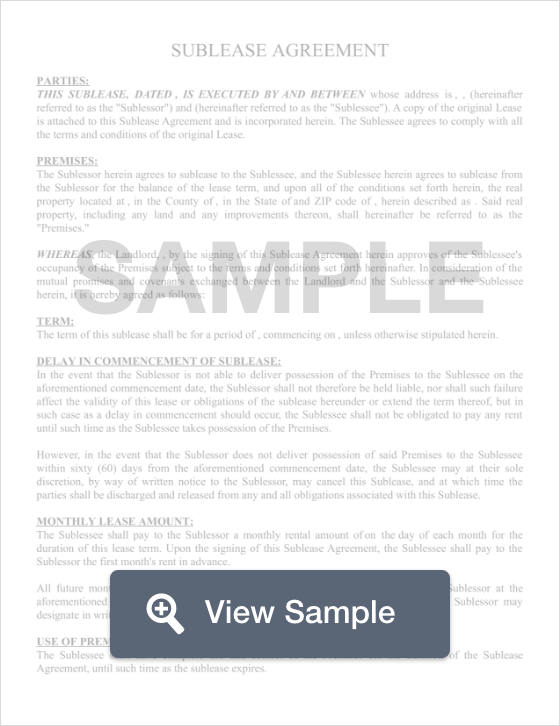
Create a Washington Sublease Agreement with our customizable template!

In Washington, a sublease agreement is a legal contract between two tenants where a new tenant will move in and take the place of the original tenant for a period of time. one who will be moving out of an apartment and one that will be moving in. A sublease agreement allows the sublessee (the new tenant) the ability to move into the unit and live just as the original tenant did; paying rent and abiding by the rules of occupancy, while the original tenant (the sublessor) is gone. Sublease agreements are highly flexible, temporary agreements that last anywhere from one month to an indefinite amount of time. Subleases can occur for any reason, from military deployment and job relocation to family emergencies and extended vacations. Regardless of the reasoning, sublease agreements should always be in writing with written permission from the landlord in order to protect all parties involved.










In the State of Washington, a tenant is instructed to follow the terms and conditions of his or her lease. If a lease prohibits the tenant from subletting, then, unfortunately, the tenant may not sublease the unit. If the lease allows subletting, then the tenant is strongly encouraged to get written permission from his or her landlord.
A sublease is an agreement between the original tenant (sublessor or sublandlord) under a lease agreement for a rental unit and a new individual (sublessee or subtenant) who does not have a direct connection with the original lease agreement; the sublease agreement is tied to and incorporates the original (master) lease. In Washington, the language in the original lease controls. If the original lease requires the permission of the landlord for the tenant to enter into a sublease, the original tenant (sublessor) must obtain written permission from the landlord to do so; if the original lease contains no language giving permission for the tenant to enter into a sublease, the original tenant (sublessor) should obtain written permission from the landlord to do so. The original tenant (sublessor) is still bound by all the requirements/obligations under the original (master) lease agreement.
A Washington sublease agreement should include the following sections:
Name of Sublessor (Sublandlord)/Name of Sublessee (Subtenant)/Name of Original Landlord: Both parties to the sublease agreement should be identified by name in the document, as well as any co-sublessors or co-sublessees. In addition, the sublease agreement in Washington must include the name and address of the landlord, as well as contact information for the landlord or manager of the property.
Names of All Other Adult Occupants: The sublease agreement should include the names of all adult persons who will be residing in the unit.
Description/Site of Rental Unit: This section should include the complete address and description of the rental unit as it appears in the original (master) lease, as well as a list of items in the unit that are covered by the sublease agreement.
Sublease Agreement Term: This section defines the length of the sublease agreement; the precise start date and end date must be noted.
Amount of Rent/How Paid: This section includes the amount of rent to be charged, whether it will be paid by the week or by the month, the day the rent is due, how the rent will be delivered to the sublessor (e.g., by a mailed check), if there will be a fee for late payment or insufficient funds, and the amounts of those fees.
Utilities/Maintenance and Repair: This section delineates the specific utilities and maintenance/repair items that are the responsibility of the sublessor and those that are the obligations of the sublessee.
Damages/Liability: This section declares the sublessee's liability for damages to the sublessor, who is still responsible for any damages that affect the landlord under the original (master) lease.
Security Deposit/Pet Deposit (if any): This section states the amount of the security deposit under the sublease agreement and that it is given to the sublessor. An additional pet deposit may be charged, as can a deposit for any use of the rental unit that poses a risk to the property. In Washington, there is no limit to the amount of the security deposit. The security deposit, less any lawful deductions, must be refunded within 21 days after the tenant/sublessee vacates.
Disputes: This section states the method(s), short of legal action, by which the sublessor and sublessee will resolve any disputes that arise.
Events of Default and Remedies: This section defines the actions on the part of the sublessee that will constitute a default or breach of the sublease agreement and the options available to the sublessor in those situations, including legal action.
Attorney's Fees: This section states that if there is a breach of the sublease agreement or legal action taken by either party, the party who secures a judgment can recover attorney's fees and court costs.
Disclosures: Applicable state law may require that certain disclosures be made to the sublessee in the sublease agreement, in addition to the federal Environmental Protection Agency (EPA) requirement to disclose the possible danger of lead-based paint if the structure was built prior to 1978. In Washington, a written Lead-Based Paint Disclosure is required if the rental unit in question was constructed prior to 1978, informing the sublessee that the premises could contain lead-based paint; notice/information regarding fire safety and protection (including an evacuation plan) and mold health hazards must also be given.
Master Lease/Termination of Master Lease: This section states that the original (master) lease is incorporated in its entirety in the sublease agreement; all of the provisions and requirements/obligations in the master lease are deemed part of the sublease agreement. The master lease should be attached. This section also states that the sublease agreement will terminate simultaneously if the master lease is terminated.
Rules and Regulations: This section states the activities that are prohibited and/or regulated, including illegal activities, smoking, and pets.
Consent of Landlord: This section states the manner in which the landlord is giving consent to the sublease agreement, should the original (master) lease not include consent.
Governing Law: This section states that the sublease agreement is governed by Washington state law, including all the provisions/requirements in the applicable state code sections.
Entire Agreement: This section states that the sublease agreement represents the complete agreement between the sublessor and sublessee; the sublease agreement may not be altered except by mutual agreement of the parties in writing.
Dated Signatures: This section includes the dated signatures of the sublessor (and any co-sublessors), sublessee (and any co-sublessees), and the landlord, who hereby gives written consent to the sublease agreement.

Create a Washington Sublease Agreement in minutes with our professional document builder.